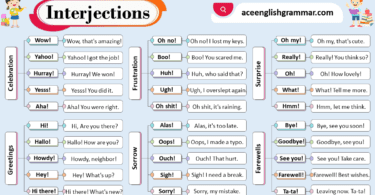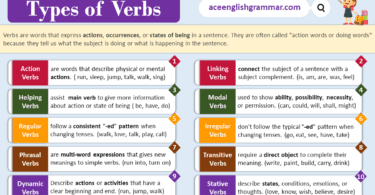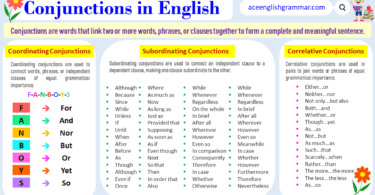Prepositions are essential parts of speech that connect nouns and pronouns to other words in a sentence. These little words help us understand the relationships between words and phrases, such as time, place, direction, and other relationships. Even though prepositions are common words, it isn’t easy to know all of them and use them correctly. However, using the wrong preposition can completely change the meaning of a sentence. In this article, we’ll explore the different types of prepositions and provide examples to help you understand their usage. So, let’s get started!
Table of Contents
What is a Preposition?
The term “preposition” comes from Latin, where “pre” means “before,” and “position” refers to the placement of something. Prepositions are called so because they are positioned before nouns or pronouns in a sentence to indicate the relationship between these elements and other parts of the sentence. They often show location, direction, time, or how something is done. They’re often placed before a noun or pronoun to indicate its position or relationship to other words in a sentence. Some prepositions are made up of multiple words, forming compound prepositions. For example, “in front of,” “next to,” or “due to.”
Examples:
- On: The book is on the table.
- At: We will meet at the park.
- To: I am going to the store.
- Under: The keys are under the mat.
- With: He painted the wall with a brush.
Types of Prepositions
Prepositions can be categorized into various types based on their functions and usage in a sentence. Here are some common types of prepositions:
- Simple preposition
- Prepositions of Place
- Prepositions of Time
- Phrasal Prepositions
- Prepositions of Direction
- Prepositions of Manner
- Prepositions of Agent
- Double Prepositions
- Prepositions of Reason
- Compound Prepositions
- Participle Prepositions
- Prepositions of Condition
- Prepositions of Source
- Prepositions of Possession
Simple Prepositions:
Simple prepositions are the foundation of prepositional phrases. They consist of a single word and are among the most common prepositions in the English language. Some examples include:
- The cat is on the table.
- The book is under the chair.
- Choose between the options.
Prepositions of Place:
These prepositions describe the location or position of an object or person. Common prepositions of place include:
- The shoes are under the bed.
- The park is next to the school.
- The car is behind the house.
Prepositions of Time:
Prepositions of time help us understand when an action takes place. Some examples include:
- We have a meeting at 3 PM.
- I will see you on Monday.
- The concert starts after the sunset.
Prepositions of Direction:
These prepositions indicate the direction of movement. Common prepositions of direction include:
- I am going to the store.
- He is coming from the library.
- We walked through the forest.
Prepositions of Manner:
Prepositions of manner explain how an action is performed. Examples include:
- She writes with a pen.
- He runs like a cheetah.
- I eat my pizza without cheese.
Prepositions of Possession:
These prepositions show ownership or possession. Common ones include:
- The car’s engine is powerful.
- The color of the sky is blue.
- The key belongs to the door.
Prepositions of Agent:
These prepositions indicate the agent or doer of an action. Examples include:
- The book was written by the author.
- The painting was created with a brush.
- Success was achieved through hard work.
Prepositions of Cause or Reason:
These prepositions explain the cause or reason behind an action. Examples include:
- The flight was delayed because of bad weather.
- The cancellation was due to technical issues.
- The match was postponed owing to rain.
Prepositions of Condition:
Prepositions of condition express the circumstances necessary for an action to take place. Examples include:
- I will go to the party if you come with me.
- Unless you finish your homework, you can’t go out.
- You can borrow my car provided you return it by 7 PM.
Double Prepositions:
Some prepositions come in pairs, and they are known as double prepositions. Examples include:
- She walked into the room.
- The cat jumped onto the table.
- The letter is upon the desk.
Compound Prepositions:
Compound prepositions are formed by combining prepositions with nouns, adjectives, or adverbs. Examples include:
- The flight was delayed because of technical issues.
- In spite of the challenges, she succeeded.
- According to the weather forecast, it will rain tomorrow.
Phrasal Prepositions:
These are groups of words that act as a single preposition. Examples include:
- We had a picnic at the park.
- I love swimming during the summer.
- She greeted me with a smile.
Participle Prepositions:
These are formed by combining a preposition with a present participle (-ing form) or past participle (-ed or irregular form). Examples include:
- I have a question regarding the new policy.
- He is concerned about the team’s performance.
- Excluding weekends, the office operates every day.
Prepositions of Source:
These prepositions indicate where something originates. Example include:
- The letter is from my cousin.
- She made a necklace out of beads.
- The cat jumped off the table.
Common Prepositions
Common Prepositions, their usage, and one example each:
| Preposition | Usage | Example |
|---|---|---|
| In | Used for months, years, countries, cities, enclosed spaces | “She lives in Pakistan.” |
| On | Used for days, dates, surfaces | “The book is on the table.” |
| At | Used for specific times, exact locations, events | “Meet me at 5 PM.” |
| By | Shows proximity, means of transport, agent in passive voice | “She sat by the window.” |
| With | Indicates a tool, instrument, or company | “He wrote with a pen.” |
| To | Indicates direction, movement, or recipient | “They are going to the mosque.” |
| From | Shows origin or starting point | “She came from Egypt.” |
| About | Used to indicate a subject or topic | “We talked about the exam.” |
| Of | Shows possession, relation, or part of something | “This is the cover of the book.” |
| For | Indicates purpose, reason, or duration | “This gift is for you.” |
| Over | Shows position above something, movement, excess | “The lamp is over the table.” |
| Under | Indicates position below something | “The keys are under the bed.” |
| Between | Used for two things or people | “She sat between Ali and Omar.” |
| Among | Used for more than two people or things | “He was among his friends.” |
Example Sentences
- I’ll meet you at the park.
- The book is under the bed.
- She is sitting beside me.
- The sun rises in the east.
- We will meet at the park.
- The keys are on the table.
- The movie will start at 7 PM.
- He walked into the room.
- The school is next to the library.
- We’ll have lunch at noon.
- The cat jumped onto the chair.
- I will see you on Monday.
- She walked toward the store.
- The dog ran away from the house.
- The party is on the weekend.
- The painting is on the wall.
- They arrived at the airport early.
- The bird is flying above the trees.
- The ball is between the two chairs.
- The cat is hiding behind the curtain.
- I found my keys under the couch.
- The train is arriving at the station.
- We will go on a trip in spring.
- The store is next to the bank.
- The restaurant is across from the park.
FAQs
Q1: What is a preposition?
A preposition is a word that shows the relationship between a noun or pronoun and other elements in a sentence. It usually indicates location, direction, time, or the relationship between different elements.
Q2: How do prepositions relate to time?
Prepositions can indicate specific times, durations, or points in time. For example, “at” for specific times (“at 3 PM”), “in” for general times (“in the morning”), and “for” for durations (“for two hours”).
Q3: How many types of prepositions are there?
Prepositions can be categorized into several types, including prepositions of time, place, direction, agent, manner, and more. There is no fixed number of types, as they can be classified based on different criteria.
Q4: What is the difference between ‘in,’ ‘on,’ and ‘at’?
“In” is used for larger, enclosed spaces or periods of time. “On” is used for surfaces, and “at” is used for specific points in time or locations.
Q5: What are the 8 basic types of prepositions?
The eight basic types of prepositions are:
- Time Prepositions
- Place Prepositions
- Direction Prepositions
- Phrasal Prepositions
- Participle Prepositions
- Manner Prepositions
- Causative Prepositions
- Double Prepositions
You May Also Like:





Leave a Comment